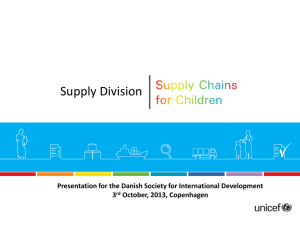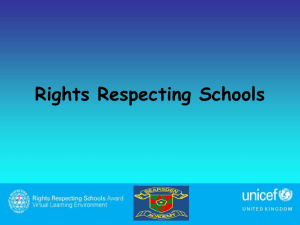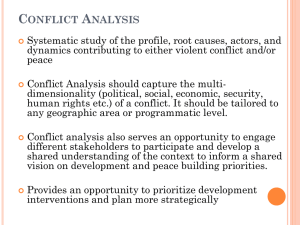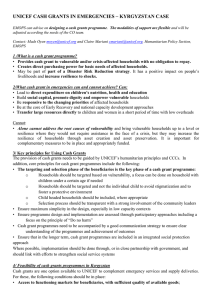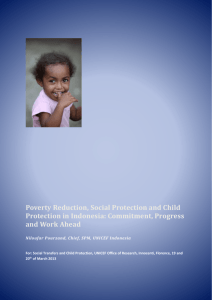UNICEF Social Protection Work an overview Show and Tell on
advertisement
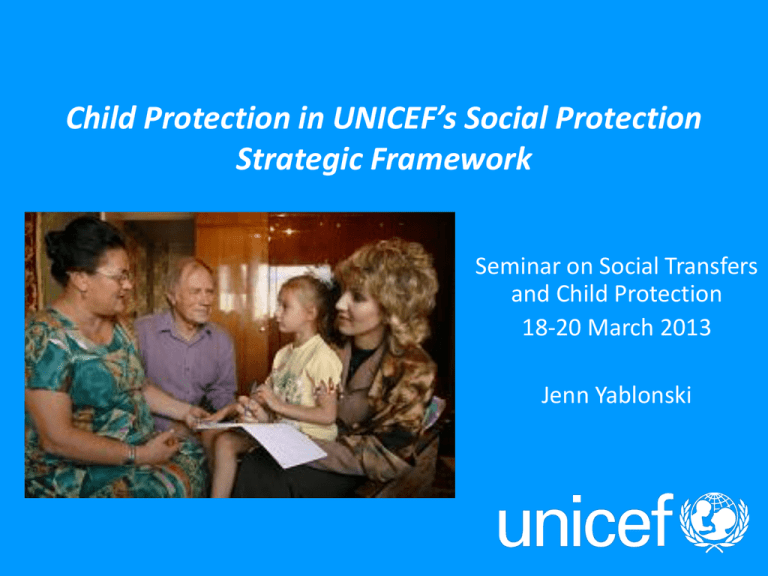
UNICEF Social Protection Work Presentation Outline an overview Show and Tell on Social Protection Child Protection in Bonn, UNICEF’s Social Protection 2011 • UNICEF andStrategic social protection Framework – Rationale: • Equity approach • Social protection and children Seminar on Social Transfers – Child-Sensitive Social Protection and Child Protection 18-20 March 2013 – Guiding Principles – On-going work Jenn Yablonski – Agenda for action – Work with Partners: Social Protection Floor Presentation Overview Child Protection and Social Protection – UNICEF context Strategic Framework on Social Protection – quick overview Child Protection and Social Protection: complementarities and challenges CP and SP - context Child Protection staff in field & HQ strongly helped to lead early work on SP in UNICEF Link to OVC issues and impact of HIV/AIDS But also broader in concerns re: child-sensitivity of SP programmes, and links to social welfare services/ministries Continues to be substantial collaboration in a number of countries/regions Child protection perspective has helped to shape part of UNICEF’s value added in SP Areas of confusion remain, and unrealized potential for maximizing outcomes for children Integrated Social Protection Systems: Enhancing Equity for Children Key Messages • Social protection strengthens resilience and helps achieve greater equity • UNICEF supports the Progressive Realization of Universal Coverage • Social protection can be affordable and sustainably financed • UNICEF promotes integrated social protection systems • Social, as well as economic, vulnerabilities need to be addressed by social protection • The Framework is a starting point for a collaborative agenda on joint learning and action Definition UNICEF understands social protection as: “a set of public and private policies and programmes aimed at preventing, reducing and eliminating economic and social vulnerabilities to poverty and deprivation” Key elements of definition: Poverty and deprivation are a multi-dimensional and dynamic reality. Vulnerability entails both exposure to risk and the capacity to respond and cope. Both economic and social vulnerabilities are important and often intertwined. Vulnerabilities are shaped by underlying structural social, political and economic factors. Social protection components & examples Cash transfers (including pensions, child benefits, poverty-targeted, seasonal) Social Transfers Food transfers Nutritional supplementation; Provision of ARVs Public works Birth registration Programmes to access services User fee abolition Health insurance Exemptions, vouchers, subsidies Specialized services to ensure equitable access for all Social Support and care Family support services Home-based care Accessible Childcare services Minimum and equal pay legislation Legislation & Policies Employment guarantee schemes Maternity and paternity leave Removal of discriminatory legislation or policies affecting service provision/access or employment Inheritance rights Overall approach: Integrated social protection systems Highly effective for addressing multiple and compounding vulnerabilities faced by children and families • Address both social and economic vulnerabilities • Provide a comprehensive set of interventions • Go beyond risk management interventions and safety nets: address structural as well as shock-related vulnerabilities • Facilitate a multi-sector approach and coordination • Coordinate with appropriate supply-side investments • Frame social protection strategies within a broader set of social and economic policies that promote human development and growth Integrated social protection systems ‘Systems’ approach ‘Multisector’ approach Integrated Social protection Systems Key Principles • Progressive realization of universal coverage • National systems and leadership • Inclusive social protection UNICEF Social Protection Work Social Protection an overview and Child Protection Show and Tell on Social Protection Bonn, 2011 Child Protection and social protection • Social protection can contribute to enhance child protection outcomes: serve as a preventive as well as protective function • Linking social protection and child protection systems/services enhance holistic well-being of children addressing both social and economic vulnerabilities to poverty, and abuse, neglect and exploitation Complementarities: Goals • Both approaches address social vulnerability, but different outcomes and underlying factors • Social protection address economic and social vulnerabilities to poverty & deprivation ensures rights to adequate standard of living and access to services. • Child protection addresses causes of violence, abuse and neglect, many rooted in economic and social vulnerability. Complementarities: Goals (cont.) Goal: address vulnerability to reduce Violence, abuse, neglect and exploitation: CHILD PROTECTION Poverty and deprivation SOCIAL PROTECTION Causes/Underlying factors Economic: limited asset base; shocks; low wage/lack of paid employment Cultural: intra-household inequality; discrimination and social exclusion based on gender, ethnicity, disability, etc; lack of extended family support; lack of social status Social: age specific health vulnerabilities; limited education and/or skills; inability to access social services Political: conflict; institutionalized discrimination; political marginalization Economic: inequality and unemployment; poverty Cultural: gender dynamics and discrimination; power relations Social: Social status; Age (children and youth); lack of family care/protection; harmful social practices, members of minority groups Disability: child or parents with disabilities Political: Conflict Programmatic linkages between SP and Child Protection • Some mechanisms and interventions can serve both child protection and social protection functions – enhancing outcomes in both areas. For example: – – Birth registration Family support services • Explicit integration and linking of child protection services with social transfers or other social protection activities may enhance the long-term impact of these interventions. • SP contact points can help identify and refer vulnerable households to social welfare services – – • Case workers Pay points (from cash transfers) Child protection services can help remove barriers to access of social protection programmes: e.g., referral services by social workers may address stigma, isolation, lack of information problems Instruments: Family support services example • What do we mean by family support services? Activities to strengthen and preserve families, prevent family separation/breakdown and ensure early intervention in families deemed at risk. As a Child protection instrument, family support services enhance capacity of families to care for children. Some activities may include: - Parenting education - Family mediation - Family legal advice - Family /individual therapeutic support - Referral to other services (part of PEF) As a Social protection instrument, family support and care services help strengthen families’ resilience and capacity to cope with risks, while linking families to basic social and other (protection, legal) services: - Home base care (for HIV patients): to provide health care for those marginalized due to poverty or stigma; promote treatment adherence; ensure access to basic services and linkages with legal support and livelihood opportunities - Referral to services and benefits (e.g: nutrition, education) due to information barriers and invisibility Protective Environment Framework (PEF): Child protection To prevent and respond to violence, abuse and exploitation Children’s life skills, knowledge and participation Government commitment to protection rights Monitoring and oversight Legislation and enforcement Capacity of those in contact with child Open discussion Social protection can enhance the capacity of care givers in terms of financial access, work flexibility, and protective legislation Basic and targeted services Social protection contributes to ensuring access to social basic services: health, education, and other Social protection legislation and policy reform to transform discriminatory attitudes towards vulnerable groups CP Impacts Intermediate Impacts SP outcomes Health, Nutrition, Family Stress/ Education Resilience outcomes Access to services - Health, Ed. Implementation Design features – e.g. synergies training/ information, childcare with PWs Systems strengthening Income/ resources HH labour/time decisions Reduced discrimination/ exclusion Programmatic linkages – e.g. referrals, birth registration Strengthening SW Coordination workforce & human resources Systems for identifying HHs/ children Access to information Family support

